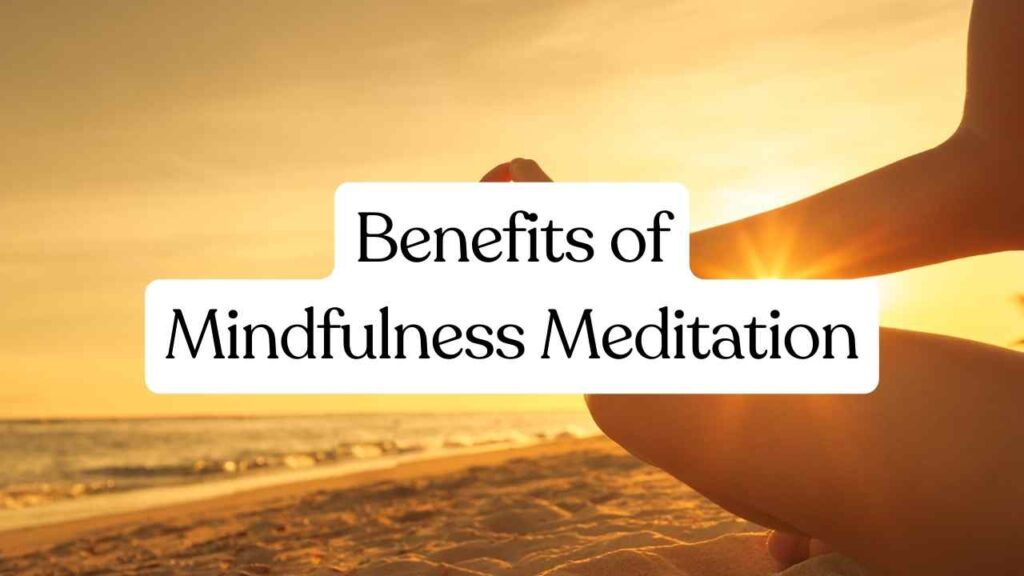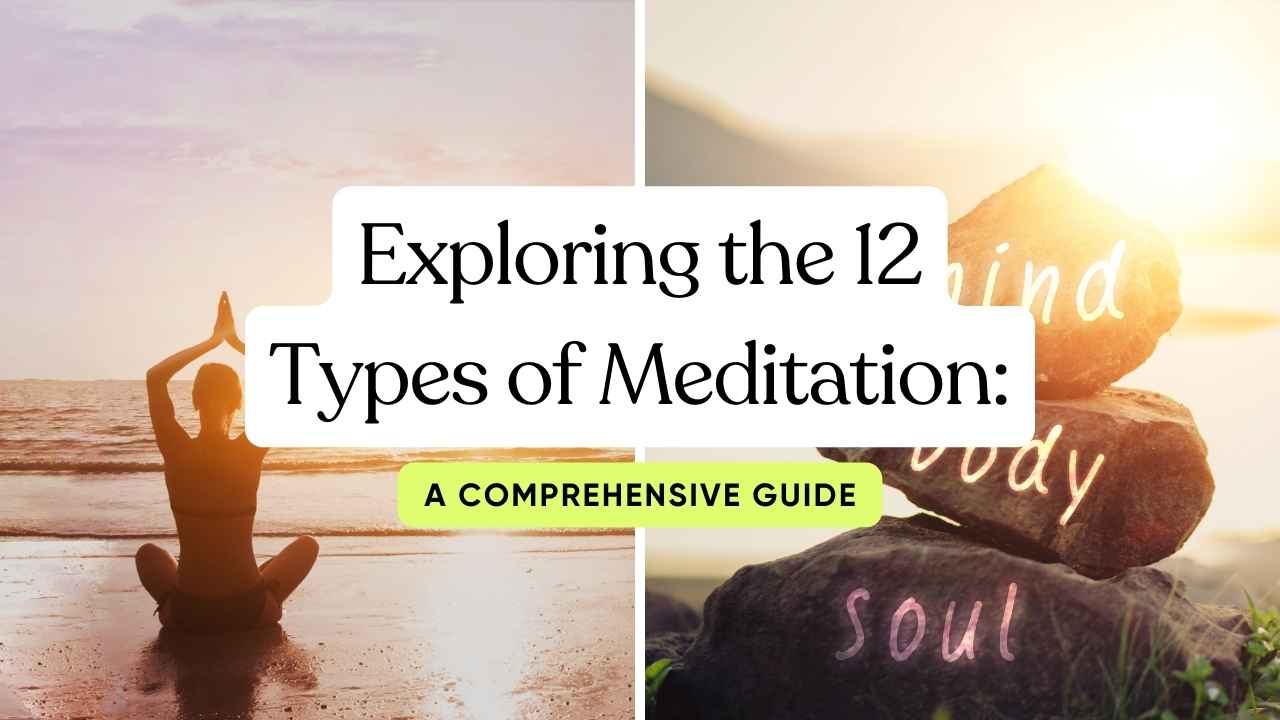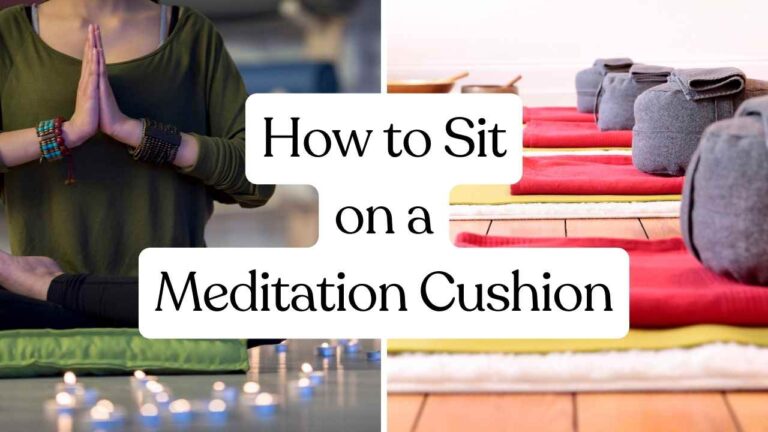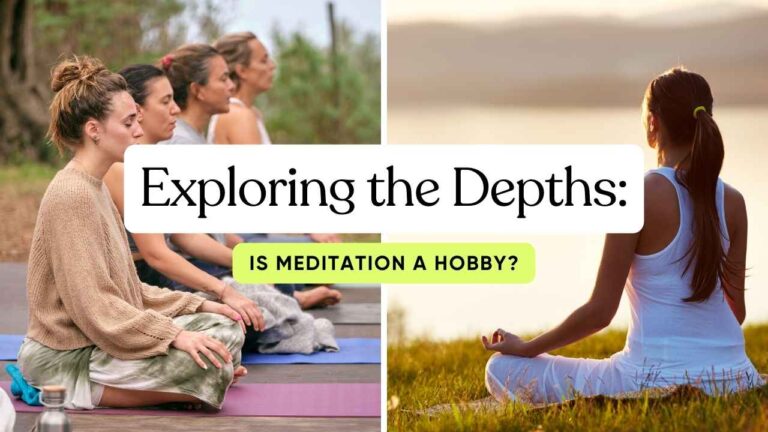Exploring the 12 Types of Meditation: A Comprehensive Guide
In this fast-paced, chaotic world, finding moments of tranquility and clarity is like discovering hidden gems in a crowded marketplace. Meditation, a practice that has stood the test of time, is key to unlocking these precious moments. In this journey through Meditation, we’ll embark on a quest to explore the 12 types of Meditation, demystify their secrets, and reveal how they can be your refuge in the storm of modern life.
Importance of Meditation in Modern Life
In today’s hustle and bustle, it’s easy to get swept away in the current of stress, anxiety, and endless distractions. Meditation emerges as your life jacket, offering solace and sanity. Its benefits are not just spiritual; they extend to the very core of your well-being. Its treasures include reduced stress, better sleep, improved concentration, and heightened self-awareness. But don’t just take my word for it; let’s dive into the 12 types of Meditation to discover how each one can be your life’s guiding star.
Let’s Explore 12 Different Types of Meditation Techniques
Alright, folks, now that we’ve dipped our toes into the tranquil waters of Meditation, let’s get to the heart of the matter. The purpose of this blog is crystal clear: we’re embarking on a thrilling expedition to uncover not one, not two, but twelve diverse meditation techniques. Each technique is like a unique flavor of ice cream, offering something special for every palate.
Our mission? Decode the mysteries behind these meditation methods, so you can choose the one that resonates with you, like your favorite song. Whether you’re a curious beginner or a seasoned meditator looking to broaden your horizons, this journey promises to be enlightening, transformative, and, dare I say, even a bit mind-blowing.
1. Mindfulness Meditation
Definition and Origin
Imagine stepping into a calm oasis within the bustling city of your mind – that’s mindfulness meditation. This ancient practice, rooted in Buddhist traditions, offers a sanctuary of serenity. At its core, mindfulness is about being fully present, transcending the past and future. It’s not tied to any religion, making it accessible to all seeking mental clarity and peace in our fast-paced world.
Benefits of Mindfulness Meditation
Now, let’s uncover the extraordinary benefits of mindfulness meditation, which can be likened to discovering hidden treasures within your mind. This practice offers many advantages, making it a must-try for anyone seeking a more balanced and fulfilling life.

- Stress Reduction: Mindfulness is your shield against the daily barrage of stress. Living in the moment can reduce anxiety, lower cortisol levels, and find a calm center amid life’s storms.
- Sharper Focus: It’s like turning a blurry lens into high-definition. Regular mindfulness practice hones your attention span and concentration, helping you precisely tackle tasks.
- Emotional Resilience: Ever wish you could keep your cool in heated situations? Mindfulness empowers you to respond thoughtfully rather than react emotionally. It’s the secret weapon of emotional intelligence.
- Improved Physical Health: Mindfulness isn’t just about the mind; it extends its healing touch to the body. It can help reduce blood pressure, boost the immune system, and improve sleep, turning you into a wellness powerhouse.
- Enhanced Relationships: Being fully present with others can deepen your connections and communicate more effectively. Mindfulness can transform your relationships, making them more meaningful and harmonious.
- Increased Self-Awareness: It’s like turning on a spotlight within. Mindfulness helps you understand your thoughts and emotions for personal growth and self-discovery.
- Pain Management: Some even use mindfulness to cope with physical pain. You can alleviate suffering and enhance your pain tolerance by redirecting your focus.
- Overall Well-Being: The sum of these benefits is a sense of well-being – a life filled with joy, contentment, and gratitude.
2. Transcendental Meditation
Explanation of Transcendental Meditation (TM)
Now, let’s embark on an exploration of Transcendental Meditation (TM). This practice can be your gateway to profound inner peace and clarity.
Transcendental Meditation, often abbreviated as TM, is a meditation technique from ancient Vedic traditions. Picture it as a journey within, a path to transcend the boundaries of ordinary thought and experience a state of pure awareness. While it has its roots in Hinduism, TM is a secular practice accessible to people of all backgrounds and beliefs.
At its core, TM involves using a mantra, a specific word or sound, silently repeated while sitting with closed eyes. This mantra acts as a vehicle, guiding your mind toward profound transcendence. It’s like sailing on the tranquil waters of your consciousness, leaving behind the noise and distractions of everyday life.
The magic of TM lies in its simplicity and effectiveness. With just 15-20 minutes of practice twice daily, you can experience profound relaxation, reduced stress, enhanced creativity, and improved overall well-being. It’s like a mental spa session, rejuvenating your mind and spirit.
How to Learn TM
So, you’re intrigued by the wonders of Transcendental Meditation (TM) and eager to embark on this transformative journey? Here’s how to dive in and make TM a part of your life.
- Find a Certified TM Teacher: Learning TM isn’t a solo endeavor; it’s like learning to dance with a skilled partner. You’ll want to find a certified TM teacher in your area to get started. These teachers undergo rigorous training to ensure you receive proper guidance.
- Attend an Introductory Lecture: Before you dive into the practice itself, attend an introductory lecture by a TM teacher. This session will provide an overview of TM, its benefits, and what to expect from the practice. It’s like getting a sneak peek of the exciting adventure ahead.
- Personal Instruction: The heart of learning TM is receiving personal instruction from a trained teacher. In this one-on-one session, your teacher will give you a unique mantra suited to your individual nature. They’ll also guide you on how to use the mantra effectively.
- Practice Twice Daily: The key to mastering TM is consistency. You’ll be encouraged to practice TM twice daily for 15-20 minutes each session. It’s like watering a plant – regular care leads to growth and blossoming.
- Attend Follow-Up Sessions: Learning TM is an ongoing journey. After your initial instruction, you’ll have follow-up sessions with your teacher to ensure you’re practicing correctly and experiencing the full benefits.
- Maintain Confidentiality: The mantra you receive during TM instruction is personalized and should be kept private. It’s like a secret key to your inner world.
- Enjoy the Journey: As you continue to practice TM regularly, you’ll likely notice the benefits unfolding in your life – reduced stress, enhanced creativity, and a more profound sense of inner peace. It’s like embarking on an adventure within your own mind.
3. Guided Meditation
Guided Meditation is a meditation experience led by a skilled guide or teacher. Think of it as a soothing, audio-assisted tour of your inner world. During a guided meditation session, the guide uses their voice to lead you through a specific meditation practice, helping you relax, focus, and explore your thoughts and emotions.
This practice is incredibly versatile and can cater to various needs and goals. Whether seeking to reduce stress, improve sleep, boost self-confidence, or simply find moments of tranquility, there’s a guided meditation.
The guide’s voice serves as your anchor, gently steering your attention and encouraging you to let go of distractions. It’s like having a trusted friend who knows the way through the labyrinth of your mind.
Guided Meditation is highly accessible, making it an excellent choice for beginners or anyone seeking structure and support in their meditation practice. You only need a quiet space, a comfortable seat or cushion, and a device to play the guided meditation audio.
4. Loving-Kindness Meditation (Metta)
Loving-Kindness Meditation is a heartwarming practice that focuses on cultivating feelings of love, compassion, and benevolence towards oneself and others. Unlike some meditation techniques that center on stillness and silence, Metta is all about sending out waves of loving-kindness to yourself, loved ones, acquaintances, and even those with whom you may have conflicts.
The heart of Metta lies in its intention—to foster unconditional love and empathy. It’s like watering the garden of your heart with seeds of kindness, nurturing them until they bloom into a beautiful bouquet of compassion.
In Metta meditation, practitioners often repeat phrases or affirmations, such as “May I be happy. May I be healthy? May I live with ease.” These positive intentions are gentle mantras guiding your thoughts and emotions toward love and goodwill.
The beauty of Loving-Kindness Meditation is its inclusivity. It doesn’t discriminate; it embraces everyone, including yourself. Through regular practice, you can experience a profound shift in your outlook, bringing more joy, empathy, and peace into your life.
5. Yoga Meditation
Welcome to the serene realm of yoga meditation, where the ancient practice of yoga takes on a new dimension. Think of it as a tranquil oasis amidst the hustle and bustle of modern life, a place where your mind and body find unity.
At its core, Yoga Meditation combines yoga’s physical postures and movements with Meditation’s mental clarity and tranquility. It’s like a peaceful conversation with your inner self while gracefully flowing through yoga poses.
Yoga, often associated with flexibility and strength, is a multifaceted discipline that encompasses well-being’s spiritual and mental dimensions. Meditation’s joining this dance adds depth and introspection to your yoga practice.
In Yoga Meditation, each asana (yoga pose) becomes an opportunity to delve deeper into your consciousness, explore the connection between your breath and movement, and cultivate mindfulness. It’s more than just stretching; it’s a journey of self-discovery and inner peace.
6. Zen Meditation (Zazen)
In Meditation, Zen Meditation, often called Zazen, stands as a serene beacon of simplicity and depth. Imagine a tranquil lake mirroring the clear sky—this is the essence of Zen Meditation.
Zazen, which translates to “seated meditation,” is at the heart of Zen Buddhism. But don’t let the word “Buddhism” intimidate you; Zazen is a practice accessible to people of all backgrounds and religions or those who simply seek inner clarity.
At its core, Zazen is about sitting in a specific posture, usually cross-legged on a cushion (zafu), with your spine straight and hands forming a mudra. It’s like adopting the posture of a sturdy oak tree—firmly rooted yet flexible.
However, Zazen is not just about sitting; it’s about being present. In Zazen, you observe your thoughts without attachment or judgment, like watching clouds pass in the sky. It’s not about emptying your mind but rather about accepting whatever arises.
Unlike meditation practices that use mantras or guided instructions, Zazen relies on following your breath and observing your thoughts. It’s like being your own lighthouse, guiding your inner ship through the seas of consciousness.
Zazen offers a path to mindfulness, clarity, and insight. It’s not about escaping the world but about finding stillness within it. With regular practice, Zazen can lead to a profound sense of presence and inner peace.
7. Vipassana Meditation
Vipassana, a Pali word, translates to “insight” or “clear-seeing,” precisely what this meditation technique is all about. Originating from the teachings of Siddhartha Gautama, known as the Buddha, Vipassana Meditation is a central practice in Buddhism. Yet, it’s not limited to any religious group. It’s an inclusive path to self-discovery.
At its core, Vipassana is the art of observing the sensations in your body and the thoughts in your mind with unwavering attention and equanimity. It’s like becoming a silent witness to the ebb and flow of your inner and outer experiences.
Unlike meditation practices that use mantras or focus on a single point, Vipassana encourages you to explore the sensations and thoughts arising in the present moment. It’s like diving into the river of your consciousness, observing the ripples and currents without judgment or attachment.
Vipassana Meditation is often practiced during silent retreats that last several days. During this time, participants maintain noble silence, which means no verbal or written communication. This retreat format allows for deep introspection and a heightened level of mindfulness.
The ultimate goal of Vipassana is to gain profound insights into the nature of impermanence, suffering, and the self, as taught by the Buddha. Through direct experience, you can cultivate wisdom, compassion, and inner liberation.
8. Chakra Meditation
Chakra Meditation is a spiritual practice rooted in ancient Indian traditions, particularly within Hinduism and Buddhism. However, it has gained popularity worldwide as a holistic approach to mental, emotional, and physical well-being.
At its core, Chakra Meditation involves aligning and balancing the seven major energy centers, or chakras, that run along your spine from the bottom to the crown of your head. Each chakra is associated with typical colors, elements, and aspects of your physical, emotional, and spiritual well-being.
The Seven Chakras:
- Root Chakra (Muladhara): Located at the bottom of your spine, this chakra is associated with grounding, survival, and stability.
- Sacral Chakra (Svadhisthana): Situated in the lower abdomen, this chakra relates to creativity, sensuality, and emotions.
- Solar Plexus Chakra (Manipura): Located in the upper abdomen, it governs your self-esteem, confidence, and personal power.
- Heart Chakra (Anahata): Discovered in the center of your chest, this chakra is about love, compassion, and emotional healing.
- Throat Chakra (Vishuddha): Situated in your throat, it’s linked to communication, self-expression, and authenticity.
- Third Eye Chakra (Ajna): Found between your eyebrows, it’s associated with intuition, insight, and spiritual awareness.
- Crown Chakra (Sahasrara): At the top of your head, it represents your connection to divine consciousness, wisdom, and enlightenment.
Chakra Meditation aims to open, balance, and cleanse these energy centers, allowing the free flow of vital life force energy (prana) throughout your body. Imagine it as tuning the strings of a musical instrument, ensuring each chakra vibrates harmoniously. During Chakra Meditation, practitioners use techniques to release blockages and restore balance, including visualization, mantra chanting and focused attention on each chakra. It’s like tending to your inner garden, ensuring that each flower blooms vibrantly.
Chakra Meditation offers a path to holistic well-being, emotional healing, and spiritual growth. It’s not just about aligning energy; it’s about aligning your life with your highest potential.
9. Body Scan Meditation
Body Scan Meditation is a mindfulness practice that invites you to systematically focus your attention on different parts of your body. Unlike some meditation methods that involve stillness or mantras, Body Scan Meditation involves mentally reviewing your body from head to toe, bringing awareness to each area as you go.
How It Works:
- Find a Comfortable Position: Begin by finding a comfortable and relaxed position, whether sitting in a chair, lying down, or even standing.
- Start at the Top: Close your eyes and bring your attention to the top of your head. Imagine a warm, gentle spotlight of awareness gradually moving from your scalp to your forehead, eyes, nose, etc.
- Notice Sensations: As you focus on each body part, pay attention to any sensations, tension, or discomfort you might feel. It’s like giving each area a friendly “hello.”
- Release and Relax: If you notice any tension or discomfort, breathe into that area and imagine it melting. Release any stress or tightness with each exhale. It’s like giving your body permission to let go.
- Continue Downward: Keep scanning down through your neck, shoulders, chest, abdomen, and so on, all the way down to your toes.
- Complete the Scan: Once you’ve scanned your entire body, take a few moments to bask in the sense of relaxation and awareness you’ve cultivated.
Body Scan Meditation is an assertive tool for grounding yourself in the present moment, reducing stress, and increasing self-awareness. It’s like taking a mini-vacation within yourself, where you return feeling refreshed and rejuvenated.
10. Taoist Meditation
Taoist Meditation, often referred to as Taoist Inner Alchemy aims to harmonize the body, mind, and spirit with the natural flow of the universe, or the Tao. It’s like becoming a leaf in the river of existence, allowing the current to guide you toward balance and enlightenment.
At its core, Taoist Meditation focuses on cultivating the Three Treasures:
- Jing (Essence): Represents the physical and vital essence of the body, often associated with sexual energy and longevity.
- Qi (Energy): Refers to the life force or essential energy that flows through the body’s meridians, similar to the concept of chi in traditional Chinese medicine.
- Shen (Spirit): Represents the spiritual aspect of the self, associated with consciousness, wisdom, and connection to the divine.
Key Elements of Taoist Meditation:
- Breath Awareness: Taoist Meditation often begins with focusing on the breath, allowing it to become natural and harmonious. Breath is seen as a bridge between the physical and spiritual realms.
- Visualizations: Practitioners may use visualizations to connect with the forces of nature, such as the elements (earth, water, fire, air), animals, or celestial bodies like the moon and stars.
- Mindful Movement: Some forms of Taoist Meditation incorporate gentle movements, similar to Tai Chi or Qigong, to stimulate energy flow and equilibrium within the body.
- Integration of the Tao: The ultimate goal of Taoist Meditation is to align with the Tao, to become one with the natural rhythm of the universe. It’s like finding your place in the grand cosmic orchestra.
Taoist Meditation is not just about personal transformation; it’s also about living in harmony with the world around you. It encourages a deep respect for nature, simplicity, and the cultivation of wisdom.
11. Christian Meditation
Christian Meditation is a practice where individuals deliberately set aside time for silent reflection, prayer, and the contemplation of sacred texts or Christian teachings. It’s like having a heart-to-heart conversation with the Divine, listening attentively for guidance and grace.
At its core, Christian Meditation is about nurturing a profound and personal relationship with God through Jesus Christ. While it shares similarities with other forms of Meditation regarding stillness and introspection, its distinctive focus is on Christian spirituality and Scripture.
Key Elements of Christian Meditation:
- Silence and Solitude: Christian Meditation often begins by finding a quiet, peaceful space where distractions are minimized. This allows practitioners to center their thoughts on God.
- Scripture and Sacred Texts: A central element of Christian Meditation involves reading and contemplating sacred texts, particularly the Bible. Meditating on Scripture passages or teachings allows individuals to deepen their understanding of faith.
- Prayer and Reflection: Prayer is integral to Christian Meditation. It’s a form of communication with God where individuals may express gratitude, seek guidance, or simply be present in God’s presence. Reflection on God’s word and His presence is a cornerstone of this practice.
- Guided Meditation: Some Christian traditions incorporate guided meditations or devotional readings to aid the process. These may include reflections on Jesus’s life, saints’ teachings, or meditations on specific virtues.
- Contemplative Listening: A key aspect of Christian Meditation is the art of reflective listening. It’s about being receptive to God’s presence and allowing His wisdom to penetrate the depths of one’s heart.
Christian Meditation is not limited to any specific denomination or Christian tradition. This practice can be embraced by Catholics, Protestants, Orthodox Christians, and various Christian denominations alike. While the techniques and approaches may vary, the overarching goal remains to draw closer to God, experience His love and grace, and cultivate a deeper faith.
12. Sound Meditation (Nada Yoga)
Nada Yoga, originating from the Indian tradition of yoga and Meditation, is a practice that centers around the profound impact of sound on the human mind and consciousness. The term “Nada” means “sound” or “vibration,” and in this context, it represents the cosmic sound that pervades the universe.
At its core, Nada Yoga is about harnessing the transformative potential of sound to connect with the inner self and the divine. It’s like tuning in to the universal radio station, where sound frequencies lead you to self-discovery and spiritual awakening.
Key Elements of Sound Meditation (Nada Yoga):
- Listening to Inner Sound: In Nada Yoga, practitioners listen to the inner sound, believed to exist within every individual. This inner sound can take various forms, such as a gentle hum, a melodious tone, or flowing water.
- Mantra and Chanting: Mantras, sacred syllables, or chants invoke specific vibrations and energies. Repeating these mantras or chants helps focus and attune the mind to the cosmic sound.
- Meditative Music: The use of musical instruments, such as singing bowls, gongs, and flutes, is common in Sound Meditation. The vibrations and harmonies these instruments create aid in deepening the meditative experience.
- Silent Listening: Beyond external sounds, Nada Yoga encourages practitioners to listen to the subtle inner vibrations and sounds that arise during Meditation. This inner listening fosters a sense of inner peace and self-awareness.
- Union with the Divine: Nada Yoga seeks to facilitate a union with the divine through sound. It’s like finding the key to a hidden door that opens into a realm of higher consciousness and spiritual connection.
Nada Yoga is not limited to any specific religion or belief system. It is a universal technique that transcends cultural boundaries, inviting individuals to explore the depths of their consciousness through sound.
12 Types of Meditation: Conclusion
In Meditation, we’ve embarked on a journey through twelve diverse practices, each offering a unique path to inner peace and self-discovery. From Mindfulness Meditation’s serene presence to the harmonious vibrations of Sound Meditation, these techniques are like keys unlocking the door to our inner worlds.
As we navigate the complexities of modern life, Meditation serves as a timeless refuge, offering solace, clarity, and spiritual growth. Whether you’re seeking stillness, insight, or a deeper connection with the divine, there’s a meditation practice suited to your journey.
In the silence of Meditation, we find the wisdom of ages, the power of self-awareness, and the boundless potential for inner transformation. As you explore this vast landscape, may your meditation journey be a source of peace, insight, and profound self-discovery?






One Comment